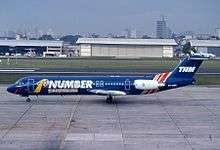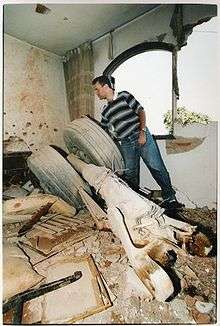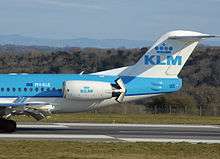TAM Transportes Aéreos Regionais Flight 402
TAM Transportes Aéreos Regionais Flight 402 was a scheduled domestic flight from Congonhas – São Paulo International Airport in São Paulo, Brazil to Recife International Airport in Recife via Santos Dumont Airport in Rio de Janeiro. On 31 October 1996, at 8:27 (UTC-2), the starboard engine of the Fokker 100 operating the route reversed thrust while the aircraft was climbing away from the runway at Congonhas. The aircraft stalled and rolled beyond control to the right, then struck two buildings and crashed into several houses in a heavily populated area only 25 seconds after takeoff. All 95 people on board were killed, as well as another 4 on the ground. It is the fourth deadliest accident in Brazilian aviation history, the second at the time. It is also the deadliest aviation accident involving a Fokker 100.[1][2][3]
 PT-MRK, the aircraft involved in the accident at the same airport on March 14, 1996, 7 months prior to the crash. | |
| Accident | |
|---|---|
| Date | 31 October 1996 |
| Summary | Mechanical failure; uncommanded deployment of thrust reverser after takeoff |
| Site | Jabaquara, São Paulo, Brazil |
| Total fatalities | 99 (95 in the aircraft and 4 on the ground) |
| Aircraft | |
| Aircraft type | Fokker 100 |
| Operator | TAM Transportes Aéreos Regionais |
| IATA flight No. | JJ402 |
| ICAO flight No. | TAM402 |
| Call sign | TAM 402 |
| Registration | PT-MRK |
| Flight origin | Congonhas-São Paulo Airport, São Paulo, Brazil |
| Stopover | Santos Dumont Airport, Rio de Janeiro, Brazil |
| Destination | Recife International Airport, Recife, Brazil |
| Occupants | 95 |
| Passengers | 89 |
| Crew | 6 |
| Fatalities | 95 |
| Survivors | 0 |
| Ground casualties | |
| Ground fatalities | 4 |
Aircraft
The aircraft involved was a Fokker 100 with the registration PT-MRK. The aircraft made its first flight on 8 February 1993 and was acquired second-hand by TAM Transportes Aéreos Regionais in April 1995; it had accumulated more than 8,000 flying hours. It wore a special promotional blue livery on its fuselage with the inscription "Number 1", in reference to TAM being awarded "Regional Airline of the Year" by Air Transport World magazine.
Crew
The Captain was 35-year-old José Antonio Moreno, who had more than 9,000 hours of flight experience, including 3,000 hours on the Fokker 100. The first officer was 27-year-old Ricardo Luis Gomes, who had 4,000 flying hours, including 160 hours on the Fokker 100. There were also five flight attendants on board.[4]
Accident

The Fokker 100 aircraft incorporates a safety system to deal with an accidental deployment of a thrust reverser on take-off or when in flight; the system automatically moves the thrust control of the affected Rolls-Royce Tay 650-15 engine to reduce power, the aeroplane then being capable of climbing out safely on the full power of the one unaffected engine, or of maintaining normal flight at reduced power. In addition, a micro-switch, activated by the aircraft's main landing gear leaving the ground, disables the thrust reverser operating circuitry, preventing inadvertent operation of the thrust reverser in flight.

As the aircraft lifted off the runway on the accident flight with both engines at full power, a faulty switch in conjunction with a possible short circuit caused the right engine's thrust reverser to deploy. The imbalance of power resulted in the aircraft rolling and veering to the right as it was climbing away from the runway. The safety system automatically cut the power to the engine suffering the thrust reverser malfunction. There was no alarm or other indication in the cockpit to indicate that a thrust reverser had been accidentally deployed. The crew had no way of knowing what the true problem was. The copilot, seeing the right engine power lever automatically move to the closed position, thought that the lever had slipped back due to a problem with the autothrottle system and pushed it back to the full power position alongside the left engine throttle lever. Once again, the automatic safety system closed the right engine throttle and the captain, who was conducting the takeoff, called for the autothrottle system to be switched off. After switching off the system, the copilot again pushed the right engine power lever fully forward and forcefully held it there.
The safety system cable, responsible for pulling the power lever to the idle position, was no longer able to withstand the physical strain of being pulled one way by the actuator, while the copilot forced it the other way by pushing the throttle lever to the fully open position — the cable soon parted at a maintenance connection. With the lever no longer restrained by the safety system, the copilot continued to hold the right throttle fully open. The combination of the right engine at full thrust in reverse and the left engine still at normal forward take-off thrust caused the aircraft to roll violently to the right and descend into the ground.[5]
Investigation
In the subsequent investigation it was discovered that the flight crew had not been trained for such an occurrence as the aircraft's manufacturer, Fokker, had judged the failure mode to be so remote a possibility that training for recovery was not necessary.[6]
Dramatization
The crash was featured in the 15th season of the television documentary series Mayday in an episode titled "Carnage in São Paulo".[7]
See also
- Lauda Air Flight 004, an accident involving in-flight thrust reverser deployment.
- Pacific Western Airlines Flight 314, an accident involving in-flight thrust reverser deployment.
- Mandala Airlines Flight 091, similar accident but with improper flap deployment.
- TAM Airlines Flight 3054, an accident that took place while landing at Congonhas.
References
- Germano da Silva, Carlos Ari César (2008). "Vinte e quatro segundos". O rastro da bruxa: história da aviação comercial brasileira no século XX através dos seus acidentes 1928-1996 [The witch trail: history of Brazilian commercial aviation in the 20th century through its accidents 1928-1996] (in Portuguese) (2 ed.). Porto Alegre: EDIPUCRS. pp. 376–81. ISBN 978-85-7430-760-2.
- "Geographical regions > Brazil air safety profile". Aviation Safety Database. Aviation Safety Network. Retrieved 2019-03-31.
- "Aircraft type index > Fokker 100". Aviation Safety Database. Aviation Safety Network. Retrieved 2019-03-31.
- "Pilotos - TAM 402". Folha de S. Paulo. Archived from the original on 2017-07-26. Retrieved 26 July 2017.
- "Aircraft accident Fokker 100 PT-MRK São Paulo – Congonhas Airport, SP (CGH)". Aviation safety network. Retrieved 2019-03-31.
- "Síntese do relatório da Aeronáutica sobre a queda do vôo 402" [Summary of the Aeronautics report on the fall of flight 402]. Folha de S. Paulo (in Portuguese). 1997-12-12. Retrieved 2019-03-31.
- "Carnage in São Paulo". Mayday. Season 15. 2016. Discovery Channel Canada / National Geographic Channel.